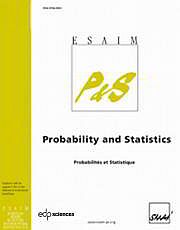No CrossRef data available.
Article contents
Estimating a discrete distribution via histogram selection
Published online by Cambridge University Press: 22 February 2011
Abstract
Our aim is to estimate the joint distribution of a finite sequence of independent categorical variables. We consider the collection of partitions into dyadic intervals and the associated histograms, and we select from the data the best histogram by minimizing a penalized least-squares criterion. The choice of the collection of partitions is inspired from approximation results due to DeVore and Yu. Our estimator satisfies a nonasymptotic oracle-type inequality and adaptivity properties in the minimax sense. Moreover, its computational complexity is only linear in the length of the sequence. We also use that estimator during the preliminary stage of a hybrid procedure for detecting multiple change-points in the joint distribution of the sequence. That second procedure still satisfies adaptivity properties and can be implemented efficiently. We provide a simulation study and apply the hybrid procedure to the segmentation of a DNA sequence.
Keywords
Information
- Type
- Research Article
- Information
- Copyright
- © EDP Sciences, SMAI, 2011

